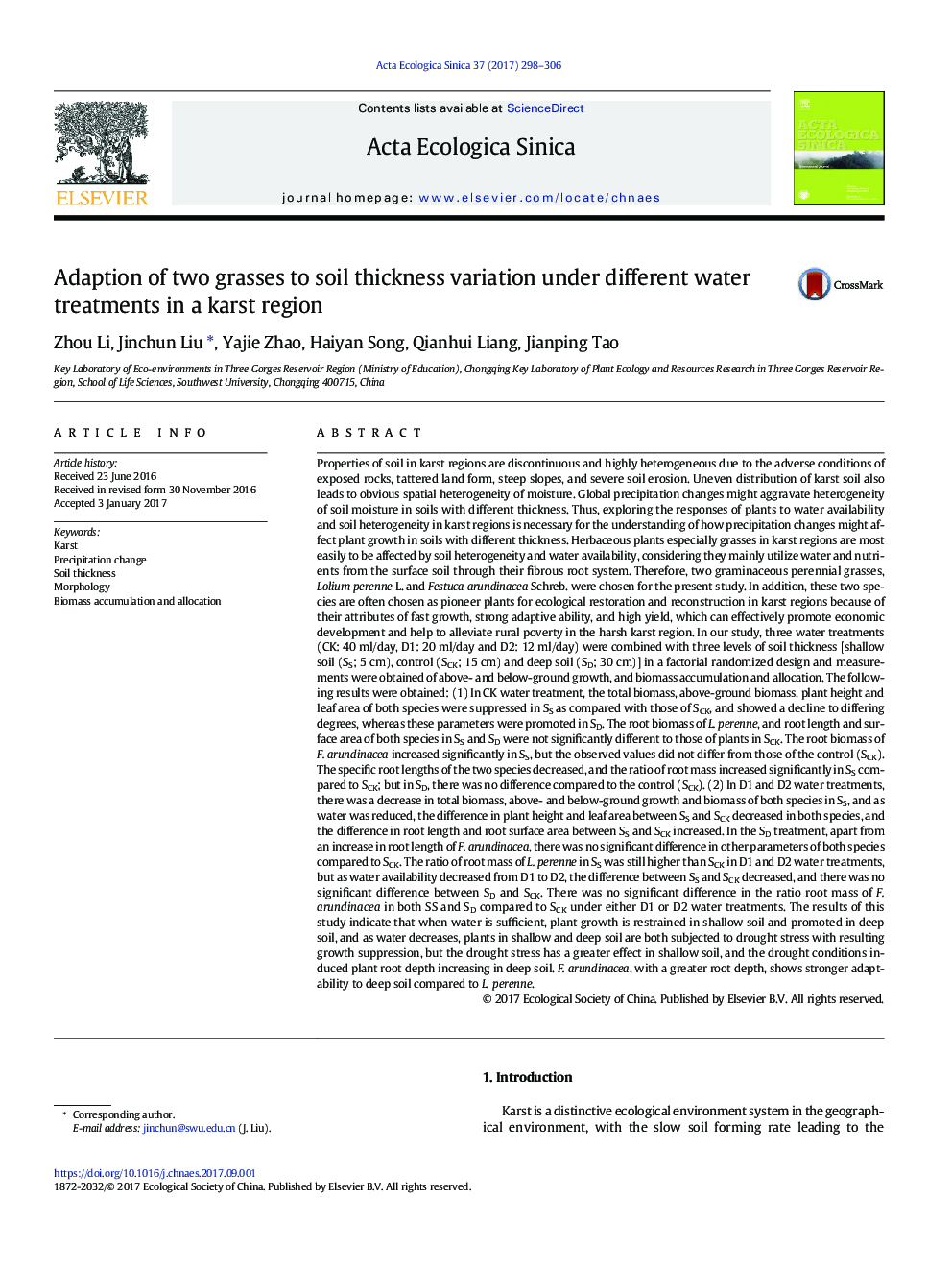| Article ID | Journal | Published Year | Pages | File Type |
|---|---|---|---|---|
| 8846349 | Acta Ecologica Sinica | 2017 | 9 Pages |
Abstract
Properties of soil in karst regions are discontinuous and highly heterogeneous due to the adverse conditions of exposed rocks, tattered land form, steep slopes, and severe soil erosion. Uneven distribution of karst soil also leads to obvious spatial heterogeneity of moisture. Global precipitation changes might aggravate heterogeneity of soil moisture in soils with different thickness. Thus, exploring the responses of plants to water availability and soil heterogeneity in karst regions is necessary for the understanding of how precipitation changes might affect plant growth in soils with different thickness. Herbaceous plants especially grasses in karst regions are most easily to be affected by soil heterogeneity and water availability, considering they mainly utilize water and nutrients from the surface soil through their fibrous root system. Therefore, two graminaceous perennial grasses, Lolium perenne L. and Festuca arundinacea Schreb. were chosen for the present study. In addition, these two species are often chosen as pioneer plants for ecological restoration and reconstruction in karst regions because of their attributes of fast growth, strong adaptive ability, and high yield, which can effectively promote economic development and help to alleviate rural poverty in the harsh karst region. In our study, three water treatments (CK: 40Â ml/day, D1: 20Â ml/day and D2: 12Â ml/day) were combined with three levels of soil thickness [shallow soil (SS; 5Â cm), control (SCK; 15Â cm) and deep soil (SD; 30Â cm)] in a factorial randomized design and measurements were obtained of above- and below-ground growth, and biomass accumulation and allocation. The following results were obtained: (1) In CK water treatment, the total biomass, above-ground biomass, plant height and leaf area of both species were suppressed in SS as compared with those of SCK, and showed a decline to differing degrees, whereas these parameters were promoted in SD. The root biomass of L. perenne, and root length and surface area of both species in SS and SD were not significantly different to those of plants in SCK. The root biomass of F. arundinacea increased significantly in SS, but the observed values did not differ from those of the control (SCK). The specific root lengths of the two species decreased, and the ratio of root mass increased significantly in SS compared to SCK; but in SD, there was no difference compared to the control (SCK). (2) In D1 and D2 water treatments, there was a decrease in total biomass, above- and below-ground growth and biomass of both species in SS, and as water was reduced, the difference in plant height and leaf area between SS and SCK decreased in both species, and the difference in root length and root surface area between SS and SCK increased. In the SD treatment, apart from an increase in root length of F. arundinacea, there was no significant difference in other parameters of both species compared to SCK. The ratio of root mass of L. perenne in SS was still higher than SCK in D1 and D2 water treatments, but as water availability decreased from D1 to D2, the difference between SS and SCK decreased, and there was no significant difference between SD and SCK. There was no significant difference in the ratio root mass of F. arundinacea in both SS and SD compared to SCK under either D1 or D2 water treatments. The results of this study indicate that when water is sufficient, plant growth is restrained in shallow soil and promoted in deep soil, and as water decreases, plants in shallow and deep soil are both subjected to drought stress with resulting growth suppression, but the drought stress has a greater effect in shallow soil, and the drought conditions induced plant root depth increasing in deep soil. F. arundinacea, with a greater root depth, shows stronger adaptability to deep soil compared to L. perenne.
Related Topics
Life Sciences
Agricultural and Biological Sciences
Ecology, Evolution, Behavior and Systematics
Authors
Zhou Li, Jinchun Liu, Yajie Zhao, Haiyan Song, Qianhui Liang, Jianping Tao,
